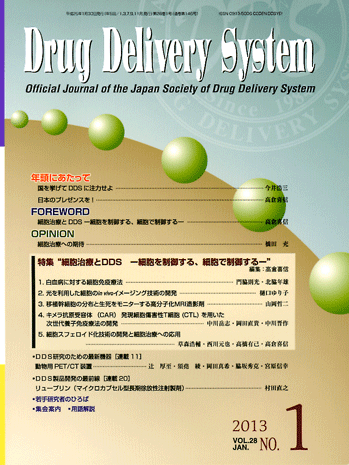All issues

Volume 28 (2013)
- Issue 5 Pages 396-
- Issue 4 Pages 270-
- Issue 3 Pages 180-
- Issue 2 Pages 92-
- Issue 1 Pages 10-
Volume 28, Issue 1
JANUARY
Displaying 1-5 of 5 articles from this issue
- |<
- <
- 1
- >
- >|
Feature articles “Cell Therapy and Drug Delivery Systems: Control of Cells and Control with Cells” Editor:Yoshinobu Takakura
-
Norimitsu Kadowaki, Toshio Kitawaki2013Volume 28Issue 1 Pages 10-16
Published: January 30, 2013
Released on J-STAGE: April 30, 2013
JOURNAL FREE ACCESSRelapse after chemotherapy is inevitable in the majority of patients with leukemia. Thus, it is necessary to develop novel therapies that have different antileukemic mechanisms. Recent advances in immunology and identification of promising leukemia-associated antigens open the possibilities for eradicating minimal residual diseases by antigen-specific immunotherapy after chemotherapy. Several methods have been pursued as immunotherapies for leukemia: peptide vaccines, granulocyte-macrophage colony stimulating factor-secreting tumor vaccines, dendritic cell vaccines, and adoptive T cell therapy. Whereas immunogenicity and clinical outcomes are improving in these trials, severe adverse events were observed in highly avid engineered T cell therapies, indicating the importance of the balance between effectiveness and side effects in advanced immunotherapy. Such progress in inducing antitumor immune responses, together with strategies to attenuate immunosuppressive factors, will establish immunotherapy as an important armament to combat leukemia.View full abstractDownload PDF (551K) -
Yuriko Higuchi2013Volume 28Issue 1 Pages 17-23
Published: January 30, 2013
Released on J-STAGE: April 30, 2013
JOURNAL FREE ACCESSCell dynamics involving distribution, adhesion, differentiation etc. is an important factor which decides therapeutic outcome in cell therapy. To investigate cell dynamics, in vivo imaging would be an promising tool. There are several types of imaging methods for tracing cells in vivo such as MRI, PET, SPECT, optical imaging. Each method possesses its own merit or demerit; therefore we should carefully select appropriate imaging method to the purpose. In this section, I would like to summarize optical imaging to visualize the dynamics of cells in vivo , and also to introduce our recent study.View full abstractDownload PDF (1617K) -
Tetsuji Yamaoka2013Volume 28Issue 1 Pages 24-34
Published: January 30, 2013
Released on J-STAGE: April 30, 2013
JOURNAL FREE ACCESSStem cell transplantation therapy is attracting attentions, recently. However, not only its therapeutic mechanism but also the information about stem cell fate after transplantation was not clarified yet. We have been developing a novel cell tracking system based on polymeric MRI contrast agent that has highly bioinert water soluble polymeric carriers. This system enabled us a quantitative analysis of the in vivo viability of the transplanted stem cells in addition to their distribution. In order to achieve long and stable intracellular retentivity, polymers that interact with cell membrane very weakly and were not internalized by the cells were selected. The polymeric-gadolinium contrast agent was delivered into the stem cells by the electroporation system. We then have proved its great efficacy by showing the stemcell migration and survival in endothelial progenitor cell transplantation to rat hind limb ischemia models.View full abstractDownload PDF (2166K) -
Takeshi Nakagawa, Naoki Okada, Shinsaku Nakagawa2013Volume 28Issue 1 Pages 35-44
Published: January 30, 2013
Released on J-STAGE: April 30, 2013
JOURNAL FREE ACCESSAdoptive immunotherapy, relying on the transfer of tumor-specific cytotoxic T-lymphocytes (CTL) differentiated from CD8+ T cells of cancer patient, is autologous cell therapy attempting tumor regression and suppression of metastasis and recurrence. However, it is difficult to induce sufficient number of tumor-specific CTLs from most patients who are in immunosuppression. As a way out, development of the technique to create CTLs expressing chimeric antigen-receptor (CAR) is pushed forward. CAR comprises an extracellular target molecule recognition domain fused to a transmembrane domain and cytoplasmic signal transduction domain capable of modifying CTL function. Herein, we review trend of the CAR study and our next-generation adoptive immunotherapy using tumor vessel-specific CAR-expressing CTL.View full abstractDownload PDF (1293K) -
Kosuke Kusamori, Makiya Nishikawa, Yuki Takahashi, Yoshinobu Takakura2013Volume 28Issue 1 Pages 45-53
Published: January 30, 2013
Released on J-STAGE: April 30, 2013
JOURNAL FREE ACCESSRecent great advances in the preparation and culture of cells have expanded the expectation of therapeutic treatment using cells as "drugs". Cells play pivotal roles in biological processes through the interaction with surrounding cells and extracellular matrix. Therefore, multicellular spheroids, which can be obtained by culturing cells in three-dimension, have attracted great attention as an administration form that maximizes the function of cells. Here we summarize and compare several approaches to preparing multicellular spheroids and introduce our recent efforts on this subject.View full abstractDownload PDF (1780K)
- |<
- <
- 1
- >
- >|